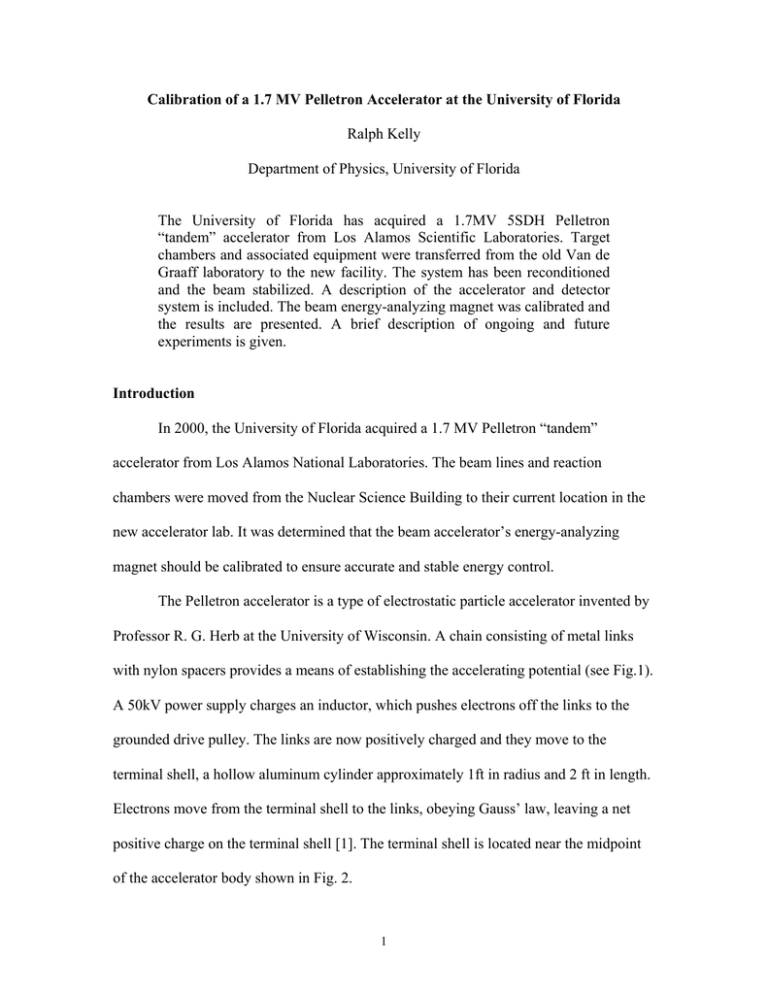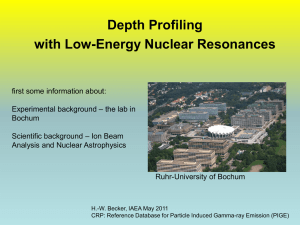Calibration of a 1.7 MV Pelletron Accelerator at the University... Ralph Kelly Department of Physics, University of Florida
advertisement

Calibration of a 1.7 MV Pelletron Accelerator at the University of Florida Ralph Kelly Department of Physics, University of Florida The University of Florida has acquired a 1.7MV 5SDH Pelletron “tandem” accelerator from Los Alamos Scientific Laboratories. Target chambers and associated equipment were transferred from the old Van de Graaff laboratory to the new facility. The system has been reconditioned and the beam stabilized. A description of the accelerator and detector system is included. The beam energy-analyzing magnet was calibrated and the results are presented. A brief description of ongoing and future experiments is given. Introduction In 2000, the University of Florida acquired a 1.7 MV Pelletron “tandem” accelerator from Los Alamos National Laboratories. The beam lines and reaction chambers were moved from the Nuclear Science Building to their current location in the new accelerator lab. It was determined that the beam accelerator’s energy-analyzing magnet should be calibrated to ensure accurate and stable energy control. The Pelletron accelerator is a type of electrostatic particle accelerator invented by Professor R. G. Herb at the University of Wisconsin. A chain consisting of metal links with nylon spacers provides a means of establishing the accelerating potential (see Fig.1). A 50kV power supply charges an inductor, which pushes electrons off the links to the grounded drive pulley. The links are now positively charged and they move to the terminal shell, a hollow aluminum cylinder approximately 1ft in radius and 2 ft in length. Electrons move from the terminal shell to the links, obeying Gauss’ law, leaving a net positive charge on the terminal shell [1]. The terminal shell is located near the midpoint of the accelerator body shown in Fig. 2. 1 FIGURE 1. Accelerator Charging System (Source: Pelletron Accelerator Charging System; http://www.pelletron.com/charging.htm) The beam of accelerated particles originates in an ion source where a hot tungsten filament emits electrons. The electrons, accelerated by approximately 150 V, pass through hydrogen gas. The interaction between the electrons and the hydrogen produces negative ions, H-. The beam of negative ions is then directed to a crossed field (magnetic and electric) analyzer, which selects ions with a well-specified q/m ratio. The ions are then injected into the accelerator tube. Once inside the tube, the ions are accelerated toward the positive terminal described in the previous paragraph. As the ions enter the terminal, they pass through nitrogen gas, which strips them of their electrons producing positive ions, H+ or simply protons [2]. Since the ions are now positive and are at a positive potential, they are accelerated a second time, hence the designation tandem (see Fig. 2). 2 FIGURE 2. Schematic of an electrostatic Pelletron S tandem accelerator (mfd. By National Electrostatics Corp.), with reaction chambers. (Source: Waldermar Scharf, Particle Accelerators, Applications in Technology and Research) As the ions leave the accelerator tube, they pass through a magnetic quadrupole lens, which focuses the beam to a small diameter (1cm or less). Then the ions enter the beam energy analyzing, or switching, magnet, which directs them into the various beam lines for use in experimentation. The beam energy-analyzing magnet works on the principle of bending the trajectory of a charged particle moving through a magnetic field. A moving charged particle has kinetic energy (Ep) equal to ½(mv2), where m is the particle’s mass and v is the particle’s velocity. A charged particle moving through a magnetic field experiences a magnetic force (Fb), which changes the direction of its travel. This change of direction creates a centripetal force (Fc). By equating the two forces, the expression (mv2)/r = qvB 3 is obtained. Solving this equation and the one for kinetic energy for v, we derive the equation, Ep = (qrB)2/(2m), where Ep is the energy of the particle, q is the charge on the particle, m is the particle’s mass, B is the strength of the magnetic field, and r is the radius through which the trajectory of the particle is bent. Nuclear magnetic resonance (NMR) permits the field strength of the beam energy analyzing magnet to be accurately measured, to within 0.5 gauss. The NMR uses “a small, untuned, probe containing a proton sample which has a resonance frequency of 4,257.59 Hz per gauss of magnetic field. The probe is placed in the field to be measured and at resonance rf energy is coupled from an integral continuous-wave (cw) transmitter, through the probe sample, to a sensitive receiver. The transmitter frequency is tuned until coupling occurs and a NMR signal is displayed on the gaussmeter cathode ray tube (CRT). A displacement of the NMR signal from the center of the CRT trace indicates a difference between the field indicated by the gaussmeter and the unknown magnetic field. When the NMR signal is centered on the CRT trace, the value of the magnetic field is displayed on the gaussmeter digital readout”[3]. As the protons exit the switching magnet, they move into the beam line, an evacuated tube connected to the target chamber. The particles with the proper trajectory (determined by their kinetic energy, q/m ratio, and the magnetic field) proceed down the center of the beam line. Prior to entering the target chamber, the particles pass through a vertical slit defined by two horizontal insulated jaws. Particles with more or less energy move to the inner or outer edges, respectively, of the beam line, encountering the slit jaws in the process. The slit jaws, thus, control the beam energy spread according to the width of the slit opening, typically a few millimeters, through which they pass. The particles 4 then proceed to the reaction chamber where they bombard samples, or targets, to be analyzed. Experimental Setup The best method to achieve an accurate calibration of accelerator beam energies in the MeV-range is to employ the beam to produce nuclear reactions that occur at known, accurately measured energies. Nuclear spectroscopists have made extensive tabulations of energy levels in nuclei, and certain levels demonstrate resonance behavior where reaction products (i. e., gamma rays or particles) are emitted in large numbers only within a very narrow range of incident particle energies. Such a reaction is 27Al + p → 28Si*, where the 28Si nucleus, exited by the incident energetic protons, subsequently emits gamma radiation. This reaction, sometimes written, 27 Al(p,γ)28Si, excites many energy states that have been determined by experimentation [3]. The energy of the radiation will be determined by the energy state to which the 28Si atom has been exited. Studies by Brostrom and Huus [4], Meyer et al [5], and Mass et al [6] have verified the existence of an isolated, well-defined resonance for the 27Al(p,γ)28Si reaction as an incident proton energy of 991.88 keV. This resonance is a widely accepted calibration energy [7] and, thus, was selected for our calibration. The Al target was placed in a reaction chamber. A NaI(Tl) scintillation detector collected the gamma radiation. Bias voltage for the detector was provided by a Tennelec TC953 Dual HVPS (High Voltage Power Supply) and set to 525 V (see Fig. 3). An Ortec 142PC Preamplifier amplified the output from the gamma detector. The signal was then amplified by a Tenellec TC242 Amplifier and fed to the multi-channel analyzer (MCA) 5 (see Fig. 3). The MCA used the AccuSpec program, from Nuclear Data Inc., installed on a Gateway 2000 PC. FIGURE 3. Schematic of detector arrangement. The AccuSpec program provides a visual display of the signals produced when gamma rays enter the detector. The gamma rays produced in the 27Al(p,γ)28Si reaction can have many different energies. The MCA display uses different channels for different energies. We used the display with 1024 channels. We used 60Co and 137Cs, which emit gamma radiation as they decay, to calibrate the MCA. The gamma radiation from 60Co has two energies, Eγ1 = 1.17 MeV and Eγ2 = 1.33 MeV. The gamma radiation from 137Cs has one decay energy, Eγ = 0.662 MeV. With channel 28 corresponding to 0.662 MeV and channel 69 to 1.33MeV, we ensured that the high energies produced in the reaction would be recorded. 6 Calibration We started with a “thick” Al target. “Thick” refers to the fact that a large fraction of the incident particles loses all of their energy in the target material. Under these circumstances, the resonance energy is somewhat more difficult to locate; particles with greater energy are slowed by collisions in the outer layers of the target and produce the resonance before they exit. We then tried a thin target of Al on a Cu backing that had been prepared for use with the old Van de Graaff accelerator. This thin target allowed us to observe the resonance with greater precision. Initially, the energy control slits had an opening of 2.14 mm, which allowed a proton energy spread, or ∆Ep, of 9.7 keV. We determined this ∆Ep by establishing the beam in the beam line with the energy set at approximately 992 keV according to the reading on the terminal voltage meter. We recorded the NMR reading and the beam current. Then we changed the magnetic field strength, thereby changing the energy of the beam, until the beam current dropped to approximately 50% of its original value. The drop in beam current indicated that the beam was hitting one side of the slit opening. We recorded the NMR reading at this point. The same procedure was used to find the point at which the beam hit the other side of the slit opening, and that NMR reading was recorded. This gave us a total analyzing magnetic field difference in gauss for the range of energies the slit opening would allow. To convert the gauss difference to a difference in keV, we multiplied by 0.7 keV/gauss, which had been determined from previous attempts at calibration. We closed the slit opening to 1.07 mm and repeated the above procedure, reducing the energy spread to ∆Ep = 5.9 keV. 7 The original controls on the magnet power supply proved unsatisfactory. With the coarse control, the finest adjustment was about 3 gauss. The fine control covered a range of about 1 gauss. This made it very difficult to obtain precise measurements. We replaced the fine control with one that had a range of about 40 gauss. This made it possible to come close to the resonance, without going past it, and to obtain measurements at intervals of 1 gauss for very precise adjustments. TABLE I. Typical data recorded for one pass over the 991.88keV resonance. MNR (gauss) Terminal voltage (kV) 2612.6 2614.4 2616.6 2617.7 2618.5 2619.5 2620.4 2621.5 2622.4 2623.5 500 500 501 501 501 502 502 502 503 503 Total counts for gamma-ray energy greater than 2.6MeV 359 369 700 935 1120 1265 1137 912 720 548 The magnetic field strength as displayed on the NMR was recorded. The terminal voltage was recorded for comparison and preliminary adjustment of the proton energy. After several trial runs, we located approximately, where the 992 keV resonance occurred with respect to the NMR. To minimize the effects of hysteresis, we cycled the magnet three times, up to about 10 kgauss and back to zero. After cycling the magnet, we 8 increased the current until the beam energy was close to, but still below, the resonance. At this point we began to increase the magnetic field, and hence the energy, by 2 gauss at a time and record the gauss value, the energy value as displayed on the terminal voltage meter, and the total number of gamma emission counts for energies greater than 2.6 MeV as recorded by the MCA (see Table1). Once the resonance became noticeable, we increased the magnetic field by 1 gauss until we were beyond the resonance, which was obvious by the display on the MCA. This procedure was repeated a total of five times on two different days to ensure that the results would be reproducible. We then plotted the total counts for Eγ greater than 2.6 MeV verses the gauss readings (see Fig. 4). From the plot, we were able to determine the peak of the resonance curve for each run. The value of the peaks ranged from 2619.5 to 2622 gauss, giving an average magnetic field in gauss, B = 2620.7 gauss. Then using the relationship, Ep = kB2, for a particle in a magnetic field, with Ep = 991.88 keV, we determined “k.” This “k” value, k =1.4442 x 10-4 keV/gauss2, is the calibration factor of the magnet. Differentiating the previous equation, we get an expression for energy range at which the resonance appears, ∆Ep =2kB∆B. Taking the difference of the B values, from all of the experimental runs, we calculated ∆B as 2.5 gauss. Therefore, ∆Ep is 1.9 keV. 9 FIGURE 4. Resonance peak for the proton energy of 991.88 keV. The gauss values are actual measurements, the energy values were calculated from Ep = kB2, with k = 1.4442 x 10-4 keV/gauss2. To verify that these values were correct, we found the resonances at Ep = 1381 keV and Ep = 1388 keV [4] (see Fig. 5). They were resolved satisfactorily, indicating that the procedure worked. The difference between the energies of the resonance peaks is in good agreement with the energies previously observed. The difference in energy between our results and those previously recorded for the individual peaks, that is 1374 keV as opposed to 1381 keV for the first peak, can be accounted for by combining the ∆Ep from the calibration calculation and the ∆Ep from the slit opening measurements for a total ∆Ep of 6.2 keV, which is very close to the difference in energy recorded. 10 4500 4000 3500 Counts 3000 2500 2000 1500 1000 500 0 1365 1370 1375 1380 1385 1390 Energy (keV) FIGURE 5. Resonance peaks for the proton energies of 1381 keV and 1388 keV. The energy values were calculated from the actual gauss measurements, Ep =kB2, with k = 1.4442 x 10-4 keV/gauss2. The distance, in energy, between the peaks is in good agreement with the accepted values. Both peaks are shifted to the low energy side by about 7 keV, which is acceptable due to a calculated ∆Ep of 6.2 keV. Conclusion Placement of a beam-defining slit in the beam line ahead of the analyzing magnet would probably improve the beam energy resolution. However, at narrow settings of the slit, the beam intensity would be limited as well, which is undesirable for most experiments. We have been able to maintain a steady beam for extended periods. The beam energy can be adjusted to acceptable limits. We determined the k value for the 30-degree beam line to be: k = 1.4442 x 10-4 keV/ gauss2 ± 6.2 keV. 11 Since we now have an acceptable procedure for calibration, we will be able to calibrate the remaining beam lines whenever necessary. We are now ready to pursue other experiments. During the calibration process, we used one of the beam lines for PIXE analysis of shell, soil, and alligator samples. The research on the soil and alligator samples is ongoing. In the future we will be setting up another bean line for Rutherford Backscattering. If all goes well, we will be installing a microprobe setup as well. Acknowledgements The author would like to acknowledge Dr. F. Eugene Dunnam, Dr. Henri A. Van Rinsvelt, and Dr. Ivan Kravchenko for their guidance, encouragement, and support and Adele Luta, a fellow REU student, for her help and enthusiasm. Also, acknowledged are the NSF and the University of Florida for financially supporting the REU program and Drs. Ingersent and Dorsey for allowing the author to participate in it. References [1] Pelletron Accelerator Charging System, http://www.pelletron.com/charging.htm. [2] Waldemar H. Scharf, Particle Accelerators- Applications in Technology and Research (Research Studies Press Ltd., Somerset, England, 1988). [3] K. J. Brostom and T. Huus, Phys. Rev. 71, 661, (1947). [4] M. A. Meyer, I.Venter and D. Reitmann, Nucl. Phys. A250, 235 (1975). [5] J. W. Maas, E. Somorjai, H. D. Graber, C. A. Van Den Wijngaart, C. Van Der Leun, and P. M. Endt, Nucl. Phys. A301, 213 (1978). [6] Jerry B. Marion, Rev. Mod. Phys., 38, 660 (1966). 12 13





